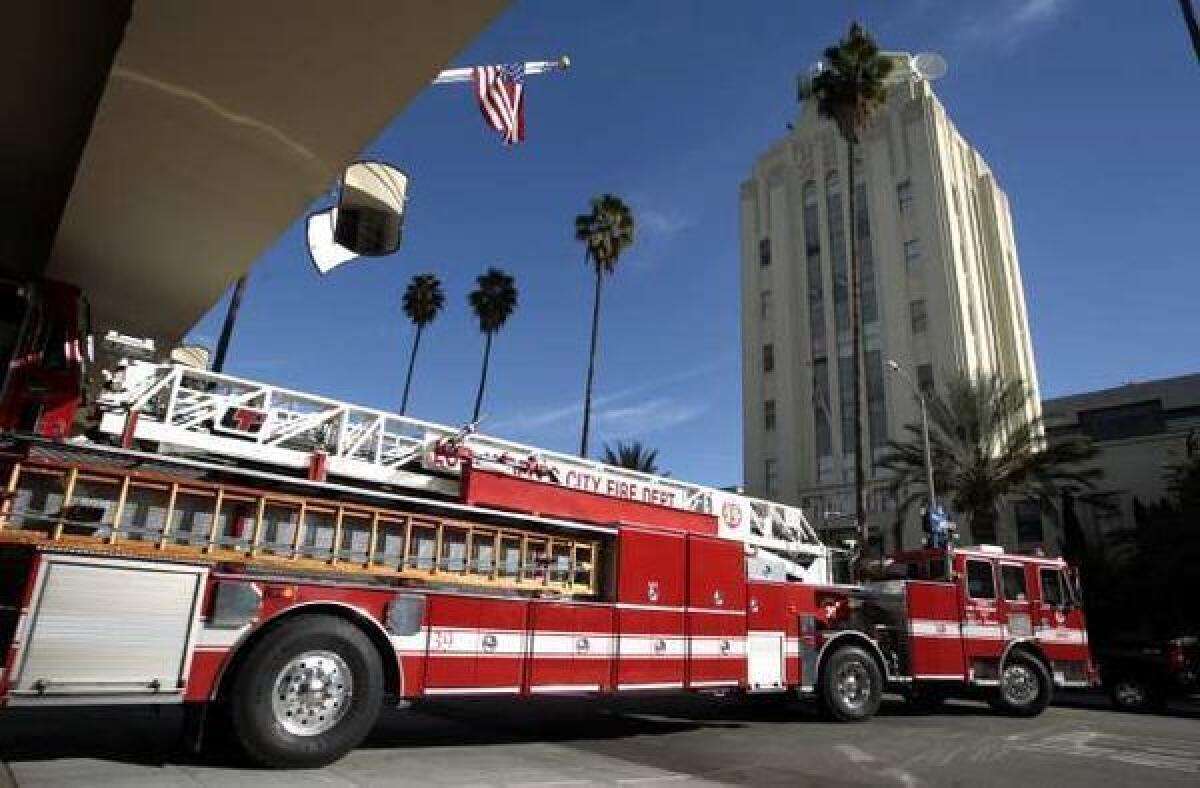LAFD plan to add ambulances opposed by union, chief officers

- Share via
With the overwhelming share of his agency’s 911 calls now requesting emergency medical care, LAFD Chief Brian Cummings is moving forward with a controversial plan to shift more firefighters from engines to ambulances.
The LAFD plans to add 11 new ambulances to its fleet of medical rescuers by transferring in firefighters from other posts, according to a draft plan circulated at Tuesday’s meeting of the city Fire Commission.
Cummings, who has been under pressure to improve response times, said the department must reconfigure its deployment practices to handle current workload demands. But the city’s firefighter union and the association representing chief officers oppose the change, saying it will put firefighters at risk.
Full coverage: Life on the line, 911 breakdowns at LAFD
Medical calls now account for more than 80% of the agency’s 911 responses, according to department officials and an independent data analysis by The Times. Fire officials say the proportion of medical emergency calls is expected to increase.
“This is an EMS provider agency,” Cummings told the commission. “That is our core business.”
When responding to both fires and medical emergencies, the LAFD often sends a ladder truck paired with a fire engine -- a combination known as a light force. The team is staffed by six firefighters, who perform a variety of roles. They are trained to operate heavy power tools that cut holes in roofs during structure fires, for example. They also use specialized equipment such as the Jaws of Life to rescue victims from the twisted wreckage of vehicle accidents.
The draft plan, which the chief said would take effect May 5, would remove a firefighter from 22 light forces across the city and shift them to non-paramedic ambulances that can respond to 911 callers who have less severe medical emergencies. The firefighters are not licensed paramedics with advanced lifesaving skills, but do have basic training as emergency medical technicians. The proposed units would increase the LAFD’s non-paramedic ambulances by about one-third, to 45, officials said.
But Capt. Frank Lima, president of United Firefighters of Los Angeles City, which represents rank-and-file LAFD members, said the chief’s proposal will put fire crews at risk by reducing key personnel needed for specialized duties during structure fires.
There will be fewer crew members on scene to do search-and-rescue operations or to hoist heavy ladders onto buildings and cut holes in roofs to release dangerous buildups of heat and toxic smoke, Lima said.
“It sounds good on paper,” Lima said of the plan. “But to have one less firefighter, it absolutely puts our firefighters at risk.”
Union leaders also expressed skepticism about the data analysis underpinning the chief’s plan and called for a more thorough, written report on the issue. Cummings said that would have to wait until next month after the changes are in place.
The chief’s sudden push for the changes drew questions from Fire Commissioner Alan Skobin, who suggested the plan might need more scrutiny. But the panel stopped short of blocking the chief, instead calling for a special meeting April 25 to review the proposal.
The department’s data analysis has been under increased scrutiny since last March, when fire officials admitted to publishing response times that made it appear rescuers arrived at emergencies faster than they actually did. A task force of experts overseen by Skobin found that fire officials responsible for crunching the numbers were poorly qualified and that previous departmental data analysis “should not be relied upon.”
A series of subsequent Times investigations found delays in processing 911 calls and summoning the nearest medical rescuers from other jurisdictions, as well as wide gaps in response times in different parts of the city. The problems worsened after cutbacks ordered by the mayor and the City Council during the economic downturn cost the department more than 300 positions.
The plan was also called into question Tuesday by Councilman Mitchell Englander, who chairs the Public Safety Committee. He plans to summon Cummings to the City Council to explain the plan.
“We know that the data has been flawed and has been wrong,” he told The Times. “I’d like to see the numbers to back it up.”
Marc Eckstein, the fire department’s medical director, said the department needs more ambulances, but he declined to endorse the chief’s plan.
“The bread and butter of the fire service in 2013 is a routine medical call,” he said. “Sending a ladder truck with an engine to a medical call? There has to be a better way.”
Cummings previously weighed a plan that would ask the City Council to restore the department cutbacks and add more staff. That plan had been demanded last year by councilmen Eric Garcetti and Mitchell Englander. But Cummings withdrew the restoration plan last month, saying it needed more work.
Lima said that the union is not opposed to adding ambulances, but that Cummings needs to approach the City Council and ask for additional funds to pay for ambulance staffing.
“Although the City Council has promised additional revenue, it’s not there,” Cummings said. “I can’t print money.”
ALSO:
Compton voters head to polls to elect new mayor
Boston bombings: Muslims fear another ‘hysteria’
Hundreds of L.A. County workers rally to demand pay raises
More to Read
Sign up for Essential California
The most important California stories and recommendations in your inbox every morning.
You may occasionally receive promotional content from the Los Angeles Times.
















